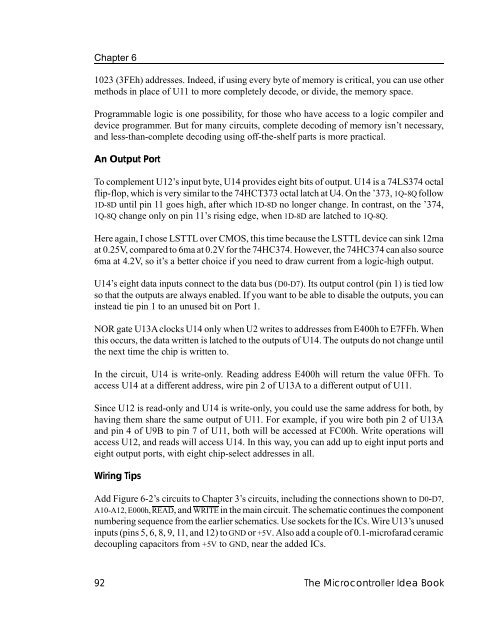The Microcontroller Idea Book - Jan Axelson's Lakeview Research
The Microcontroller Idea Book - Jan Axelson's Lakeview Research
The Microcontroller Idea Book - Jan Axelson's Lakeview Research
You also want an ePaper? Increase the reach of your titles
YUMPU automatically turns print PDFs into web optimized ePapers that Google loves.
Chapter 6<br />
1023 (3FEh) addresses. Indeed, if using every byte of memory is critical, you can use other<br />
methods in place of U11 to more completely decode, or divide, the memory space.<br />
Programmable logic is one possibility, for those who have access to a logic compiler and<br />
device programmer. But for many circuits, complete decoding of memory isn’t necessary,<br />
and less-than-complete decoding using off-the-shelf parts is more practical.<br />
An Output Port<br />
To complement U12’s input byte, U14 provides eight bits of output. U14 is a 74LS374 octal<br />
flip-flop, which is very similar to the 74HCT373 octal latch at U4. On the ’373, 1Q-8Q follow<br />
1D-8D until pin 11 goes high, after which 1D-8D no longer change. In contrast, on the ’374,<br />
1Q-8Q change only on pin 11’s rising edge, when 1D-8D are latched to 1Q-8Q.<br />
Here again, I chose LSTTL over CMOS, this time because the LSTTL device can sink 12ma<br />
at 0.25V, compared to 6ma at 0.2V for the 74HC374. However, the 74HC374 can also source<br />
6ma at 4.2V, so it’s a better choice if you need to draw current from a logic-high output.<br />
U14’s eight data inputs connect to the data bus (D0-D7). Its output control (pin 1) is tied low<br />
so that the outputs are always enabled. If you want to be able to disable the outputs, you can<br />
instead tie pin 1 to an unused bit on Port 1.<br />
NOR gate U13A clocks U14 only when U2 writes to addresses from E400h to E7FFh. When<br />
this occurs, the data written is latched to the outputs of U14. <strong>The</strong> outputs do not change until<br />
the next time the chip is written to.<br />
In the circuit, U14 is write-only. Reading address E400h will return the value 0FFh. To<br />
access U14 at a different address, wire pin 2 of U13A to a different output of U11.<br />
Since U12 is read-only and U14 is write-only, you could use the same address for both, by<br />
having them share the same output of U11. For example, if you wire both pin 2 of U13A<br />
and pin 4 of U9B to pin 7 of U11, both will be accessed at FC00h. Write operations will<br />
access U12, and reads will access U14. In this way, you can add up to eight input ports and<br />
eight output ports, with eight chip-select addresses in all.<br />
Wiring Tips<br />
Add Figure 6-2’s circuits to Chapter 3’s circuits, including the connections shown to D0-D7,<br />
A10-A12, E000h, READ, and WRITE in the main circuit. <strong>The</strong> schematic continues the component<br />
numbering sequence from the earlier schematics. Use sockets for the ICs. Wire U13’s unused<br />
inputs (pins 5, 6, 8, 9, 11, and 12) to GND or +5V. Also add a couple of 0.1-microfarad ceramic<br />
decoupling capacitors from +5V to GND, near the added ICs.<br />
92 <strong>The</strong> <strong>Microcontroller</strong> <strong>Idea</strong> <strong>Book</strong>






